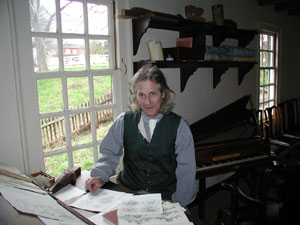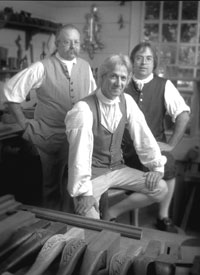
Have you ever visited Colonial Williamsburg in Virginia? You’ll stroll down 18th century streets, past original or at least authentic buildings, see people dressed in period costume, and even hear the sounds of the era. For most of the thousands who visit every year, it’s a once- or maybe twice-in-a lifetime chance to experience a few hours in Colonial America. For Williamsburg craftsmen like Mack Headley, however, it’s an everyday experience.
Mack is the master cabinetmaker at Williamsburg’s Anthony Hay Shop. Working with a team of two journeymen harpsichord makers and two journeymen cabinetmakers, he uses authentic tools and traditional techniques to recreate the 18th-century furniture.
It’s a role Mack has relished since 1976, the year of the nation’s Bicentennial, when he first came to Williamsburg. But that wasn’t the beginning of his career in woodworking. You could say that goes back three generations.
“My great-grandfather, along with my grandfather, started Headley’s Antiques back in the 1920s,” Mack explained, “which combined an antique shop, an auction business, and reproduction furniture.”
By the time Mack’s dad took over the shop, its primary focus was on reproductions and repairs. Mack recalls making toy boats and boomerangs when he was younger, but by the time he was 16 he was working regularly at the shop. Working alongside his father for 12 years, Mack used the latest joiners, planers, table saws, band saws, and hollow bit mortises, but legs or feet were all done by hand. The traditional work that came in for repairs also made a big impression on Mack, and he decided to learn more.
“I attended a lecture by Wallace Gusler,” Mack recalled, “who was a curator of furniture in Williamsburg at the time. Afterwards, I went up to meet him, and he told me that Williamsburg was looking for a cabinetmaker. The gentleman who had been running the shop for years was about to retire. It sounded like a really interesting opportunity.”
Guided by a study of Virginia colonial furniture by Wallace Gusler and studies of 18th century tools, Mack led the shop in recreating authentic Virginia pieces.

“By the 19th century, hand tools were used to trim up after a machine has really done the work,” Mack noted. “But in the 18th century design, we recognized hand tools as something you really make your livelihood with. Williamsburg had a collection of many fine antique tools, which we used for many years. Finally, we realized we were using up and destroying things that could not be replaced, so in the last 15-20 years, there has been more effort to get good reproductions of 18th-century-style tools.”
The style is based on Williamsburg’s most active period of cabinetmaking, from the 1720s or 1730s up to the Revolution, when the capital moved to Richmond and Williamsburg became a political and commercial backwater. The 50-year heyday covers a wide range of styles.
“At any time, the customers patronizing a particular shop,” Mack explained, “might have been very conservative and still liked the bold Baroque sculpture of the 1720s or 1730s. You might also have very progressive customers interested in the very latest symmetrical Rococo work. You even begin to see some of the Neo-Classical or Federal furniture that responded to discoveries at Pompeii and Herculaneum and came into Williamsburg just before the revolution.”
The vast majority of work done in the shop is based on the study of specific antiques and the cabinetmakers hold themselves to copying them & even with all their faults. This helps them understand the economics and intent behind each piece.
“The 18th Century craftsmen were definitely conscientious businessmen. Today, I think they would take every advantage of every machine. They would know when to use them, and when they were sacrificing the integrity of the piece. The finesse in their work isn’t something machines are going to help them with so much. If they saw someone who didn’t bother to train himself in geometry, didn’t bother to develop his drawing skills, and didn’t understand the grain and texture of the wood, but bypassed all that with machines, they’d think he was missing a lot.”
Mack occasionally visits woodworking schools and has to make allowances for the limitations of time and student skill.
“We were doing a Spanish foot,” Mack recalled, “and the guys cut all of their blanks out with a band saw. Most don’t have the hand tools they’d need, and I don’t have enough to supply them. It’s a compromise and a melding of old and new — much the way we did back in my dad’s shop — taking advantage of what new tools have to offer but becoming familiar with real hand skills at the same time.”
Mack enjoys discussing the nature and culture of the times with the other craftsmen and craftswomen at Colonial Williamsburg. He particularly appreciates the tools created by the blacksmith. Scholars studying and researching traditional objects provide a tremendous amount of information that he uses to relate his craft to visitors.
For years, most of the shop’s production was used in the high traffic areas in Williamsburg or used to fill out a set of a chairs that didn’t all survive.
“Now they have everything they need,” Mack explained, “and we are choosing projects to train apprentices or to study a specific 18th century cabinetmaker. We turn the finished pieces over to our products division and they handle the merchandising. It is the fairly high-end trade; after all, from raw lumber to finished products, these pieces are strictly hand tooled.”






